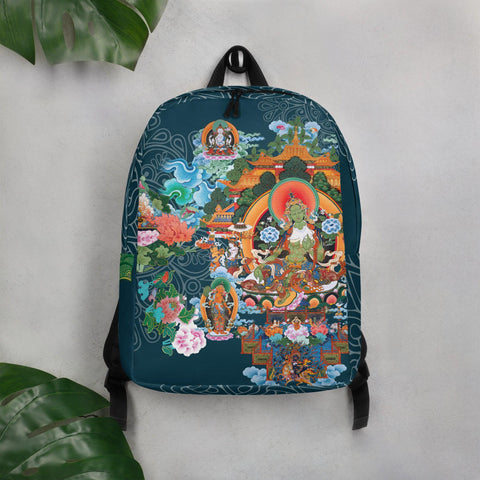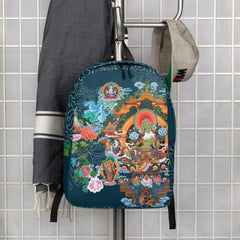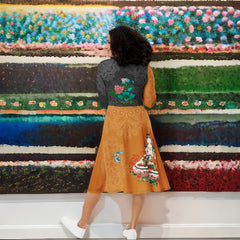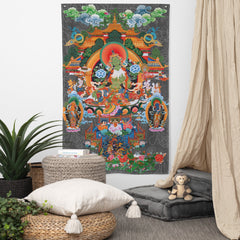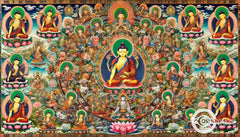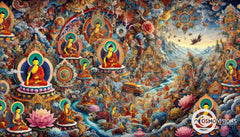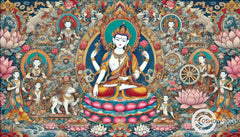Embodying the Ecofeminist Goddess: Exploring the Power of Green Tara and Mandala Connections
Posted by Massimiliano Geraci

We often search for ways to find peace and meaning in our busy lives, but we don't know how to connect with something larger than ourselves. Green Tara, a figure of compassion and wisdom in Buddhism, embodies the divine feminine, representing the essential counterpart to the masculine principle of compassion.
She is known as the “mother of all Buddhas” and teaches us about crossing over life’s challenges with grace.
This post will explore how embracing Green Tara through meditation and her mantra can bring calmness and clarity into your life. By learning about her symbolism and practicing daily meditations, you’ll start seeing changes within yourself—feeling more grounded and compassionate towards others.
Get ready to unlock a new spiritual journey with Green Tara!
Key Takeaways
1. Green Tara is a symbol of compassion and wisdom in Buddhism, known as the "mother of all buddhas." She helps followers find inner peace and enlightenment by teaching them to overcome life's challenges with grace.
2. Practicing Green Tara meditation involves visualizing her form, reciting her mantra "Om Tare Tuttare Ture Soha," and feeling her compassionate energy. This practice can purify the mind and encourage qualities like boundless love and strength.
3. The symbols associated with Green Tara, such as her green color, lotus flowers, and active posture, represent life renewal, purity rising from suffering, readiness to help others, and spiritual perfection.
4. Different forms of Tara cater to various needs: Green Tara provides immediate aid in overcoming obstacles, and White Tara provides healing and long-term support. Both lead towards liberation but focus on different aspects of human experience.
5. Engaging regularly with Green Tara's teachings through meditation or creating a dedicated space for practice can nurture personal growth in compassion and mindfulness. Sharing these practices within a community group enhances understanding and provides support.

Understanding the Significance of Green Tara in Buddhism
Green Tara is known as a female Buddha in Tibetan Buddhism and the mother of all Buddhas. She helps beings cross the ocean of suffering. People who meditate on Green Tara can find their own Buddha nature inside them. This makes her very special in Buddhism.
Her practice includes seeing her, feeling her love, becoming one with Tara, and then sending this good energy out to others.
Her mantra and form invite peace and protection from fears. Lama Palden Drolma, a teacher with deep knowledge about Tara, shows how calling on Green Tara brings many kinds of help.
Through meditation and chanting her mantra, followers connect deeply with compassion and wisdom.
Who is Green Tara, and Why is She Important?
Green Tara stands as a fully enlightened being, embodying compassion and wisdom in Buddhism. The central Green Tara is depicted surrounded by 1008 small identical Taras, each performing the mudra of generosity without a lotus in the right hand and holding the stem of a lotus blossom to the heart in the left hand. The central Green Tara is depicted with Buddha Amitabha above her and Kurukulle below her, along with various other details of her appearance and the surrounding imagery. She is known as “the mother of all the Buddhas” for her role in guiding beings across the ocean of suffering.
Her presence offers spiritual, emotional, and physical support to those who call upon her through prayer or meditation, making her an essential figure in Buddhist practices.
Meditating on Green Tara awakens one’s own inner potential for enlightenment. By connecting with Tara’s green form through meditation and reciting the Green Tara mantra, individuals open themselves to receive her blessings.
This practice not only purifies the mind but also fosters a path towards liberation from worldly attachments. Engaging with Green Tara’s teachings encourages practitioners to embody her qualities of boundless love and unwavering strength in their journey toward enlightenment and aiding others.
The Symbolism of Green Tara's Iconography
In her images, Tara sits like a queen, showing us how to be fearless and kind. Her skin is dark green, symbolizing life and nature’s renewal. This color tells us she is always ready to help those who need her.
She steps forward with one foot, ready to jump into action at any moment. This pose is not just for show; it teaches us to be active in our compassion toward others.
On every hand, Tara holds special symbols: lotuses that stand for purity and wisdom, rising above the muddy waters of desire and ignorance. She holds a lotus flower beside her left ear, symbolizing physical and spiritual purity. Her left-hand holds a lotus flower, emphasizing her compassionate and protective nature. These flowers remind us that good things can grow from difficult situations if we stay true to our path.
Tara wears silks and jewels, but they are not just decorations. They represent her enlightenment - showing that she has reached a state of spiritual perfection beyond ordinary understanding but still cares deeply about all living beings‘.
Comparing Green Tara with White Tara: Understanding the Distinctions
Moving from the vibrant imagery that colors Green Tara‘s presence, we journey into understanding her tranquility alongside White Tara. Each embodies unique aspects of compassion and protection, yet their paths diverge in symbolism and purpose.
Green Tara, often depicted seated on a lotus throne, signifies her peaceful appearance and deep connection to Buddhism. Often seen with a right foot stepping forward, she signals readiness to spring into action for those seeking refuge or aid. She is the very essence of active compassion, a beacon for those navigating the tumultuous waves of samsara.
Clothed in serene purity, White Tara radiates calm and offers longevity and healing. Her seven eyes — three on her face and one on each hand and foot — symbolize an all-seeing awareness encompassing the universe.
This goddess extends a gentle invitation to take refuge in her peaceful embrace, ensuring safety across spiritual journeys. Each form of Tara invites distinct practices; green encourages immediate assistance while white fosters enduring support.
Both offer paths to enlightenment through their enlightened activities but cater to different facets of human needs - courage from Green Tara and healing from White Tara.

Embarking on Green Tara Meditation: A Beginner's Guide
First, prepare your meditation space. Choose a quiet spot where you won't be disturbed. You might want to have an image of Green Tara there. This helps focus your mind on her qualities—compassion and wisdom.
Light a candle or some incense to make the atmosphere peaceful.
Next, follow these simple steps for Green Tara meditation. Sit comfortably with your back straight but relaxed. Close your eyes and take deep breaths to calm down. Imagine Green Tara in front of you, shining with green light representing her healing power.
Feel this light touching you, bringing peace and protection. Then silently say the Green Tara mantra: "Om Tare Tuttare Ture Soha." Think about the meaning behind each word as it's said aloud or in silence - calling on Green Tara for help and guidance.
This practice helps us connect deeply with Green Tara's energy, aiding our journey toward inner peace and enlightenment. If possible, practice daily, even for just a few minutes; consistency makes all the difference!
Preparing for Green Tara Meditation: Setting Up Your Space
Choose a quiet spot in your home for Green Tara practice. Make sure this area is clean and free of clutter. You want to create a peaceful environment where you can focus without distractions.
A cushion or chair should be there for you to sit comfortably during meditation.
Place an image or statue of Green Tara in front of you at eye level. This helps you focus and connect with her energy during the practice. Light candles and incense as offerings to set the mood and show respect for the deity practice in Vajrayana Buddhism.
The goal is to make this space special, turning it into a sanctuary where refuge in Tara becomes a transformative experience.
Step-by-Step Instructions for Green Tara Meditation
Start by finding a quiet spot. Make sure you sit in a comfortable posture. Your back should be straight but not stiff. Close your eyes gently. Take deep breaths to calm your mind.
Now, picture Green Tara before you, shining with a bright green light. She looks kind and powerful. Think of her as the embodiment of wisdom and compassion that can purify obstacles and obscurations from your life.
Invite Tara's presence into your space by reciting her mantra softly: "Om Tare Tuttare Ture Soha." Feel each syllable drawing you closer to her enlightened energy.
Open your heart to receive Tara’s love and wisdom. Imagine this as a brilliant light flowing from Tara into you, filling every part of your being with peace and strength.
Become one with Tara by seeing yourself dissolve into the light, merging with her wisdom and compassion completely.
Slowly let the visualization fade, but keep the feeling of connection strong within you.
End by dedicating this practice for the benefit of all beings everywhere, carrying forward the kindness received into everyday actions.
After mastering these steps, incorporating Green Tara Meditation into daily life becomes easier over time.
How to Incorporate Green Tara Meditation into Daily Life
After learning the basics of Green Tara meditation, it’s time to make this practice a part of everyday life. This can be done by setting aside a few minutes each day for quiet reflection and connection with Green Tara.
Picture her in your mind, recite her mantra, and let her peaceful energy fill you. You could do this early in the morning to start your day positively.
Keep a small space in your home dedicated to this practice. Place an image of Green Tara there along with some green plants or flowers to remind you of her presence and teachings throughout the day.
Whenever you pass by this space, let it serve as a reminder to embody compassion and mindfulness, just like Tara does for all living beings. Making offerings or lighting a candle here can also deepen your spiritual practice over time.
The Power of the Green Tara Mantra: Benefits and Practice
The Green Tara Mantra is a powerful chant in Tibetan Buddhism. This mantra calls upon the compassion and protection of Green Tara, the mother of all Buddhas. People who recite this mantra feel her help in their spiritual, emotional, and physical lives.
The words are simple but deep, asking for freedom from fear and suffering. Green Tara listens and brings courage to those who call on her.
To practice this mantra, start with a clear mind and a peaceful heart. Find a quiet space where you can sit comfortably without distractions. Recite the mantra slowly, focusing on each syllable.
Imagine Green Tara's presence as you chant, picturing her compassionate eyes and serene smile. Chanting connects your soul to hers—bringing hope, healing, and liberation from pain.
As you continue this practice daily, notice how your worries fade away while love and strength grow inside you.
Unraveling the Meaning Behind the Green Tara Mantra
The Green Tara Mantra is a powerful call for help, wisdom, and protection. It connects us to the mother of all Buddhas. This mantra has deep meaning. It frees us from fear and guides our minds toward enlightenment.
People say it out loud or silently in their hearts to feel closer to Green Tara's compassion.
Reciting this mantra, "Om Tare Tuttare Ture Soha" calls upon her strength and kindness. Each part of the mantra honors different qualities of Green Tara. For example, "Tare" shows she removes obstacles.
"Tuttare" means she brings liberation from all dangers. And "Ture" celebrates her power to make good things happen quickly.
Knowing how to say the Green Tara Mantra right can change your mind and body in good ways. It helps people feel more peaceful inside and ready for enlightening activity outside.
Next, we'll see how saying this mantra often deeply impacts us, making our days brighter with positivity and care.
How to Properly Recite the Green Tara Mantra for Maximum Benefit
To recite the Green Tara mantra well, find a quiet place first. Make sure you sit comfortably. You can use a cushion or chair. Keep your back straight to help focus. Hold your hands in your lap or on your knees.
This helps create a feeling of openness and readiness.
Next, take deep breaths to calm your mind. Close your eyes lightly if you wish. Focus on the image of Green Tara in front of you or in your heart. She is like a mother, full of love and ready to protect us.
Start saying the mantra slowly with respect: "Om Tare Tuttare Ture Soha." Feel each word as it comes out from deep inside you. Picture Green Tara's compassion flowing into you with every chant.
Keep chanting for as long as feels right for you—10 minutes, 20 minutes, or more if possible. Imagine Green Tara’s green light filling and surrounding you completely.
Understanding the Effects of Reciting Green Tara Mantra on Mind and Body
Reciting the Green Tara Mantra touches both mind and body deeply. This ancient chant calls upon the energy of Mother Tara, guiding those who practice it towards inner peace and emotional healing.
The words themselves hold power, aiming to liberate us from fears and obstacles that keep us from true happiness. As we voice the mantra, our breath aligns with its rhythm, calming our nervous system and bringing a sense of wellness.
This practice does more than calm us; it connects us directly to spiritual awakenings. By focusing on Tara's enlightened activity, practitioners illuminate their own paths to compassion and wisdom.
Each recitation brings us closer to understanding our place within the vast tapestry of life and encourages kindness toward all sentient beings. Through this simple yet profound act, we embody Tara's love and strength in our daily lives, spreading her light wherever we go.
Green Tara and Tibetan Buddhism: The Role of Deity Practice in Vajrayana
In Tibetan Buddhism, deity practice with figures like Green Tara plays a key role. It helps people reach enlightenment and grow their compassion. There is a growing cultural shift and recognition of the need to balance masculine and feminine energies, highlighting the 'divine feminine'. Green Tara is seen as the mother of all buddhas, guiding beings across the ocean of samsara.
Praying to her and meditating on her form can bring spiritual, emotional, and physical healing.
Lama Palden Drolma teaches that visualizing Tara involves several steps, from calming the mind to receiving her love. This process connects us deeper to our spirituality and universal compassion.
Through this practice within Vajrayana Buddhism, followers aim to awaken their own buddhanature following guidance from respected lamas like Lama Palden Drolma.
The Importance of Deity Practice in Tibetan Buddhism
Deity practice in Tibetan Buddhism uses figures like Green Tara to help people grow spiritually. Green Tara, seen as the "mother of all buddhas," plays a key part in this. By focusing on her, practitioners can awaken their buddhanature.
This involves visualization techniques and mantra recitation. These methods are not just about seeing an image in your mind. They make the qualities of compassion and enlightenment more real for the person meditating.
This type of meditation connects deeply with practices such as dharma and tantra within Vajrayana Buddhism, drawing from centuries-old traditions. Through invoking names like Arya Tara and chanting mantras, followers seek to bring spiritual, emotional, and physical wellness into their lives.
The process emphasizes direct engagement with deities like Green Tara to encourage a state of meditation that is rich with meaning. This leads toward universal compassion and liberation – goals central to the path towards enlightenment outlined by figures such as Dalai Lama and Rinpoche within this rich spiritual heritage.
How Green Tara Practice Facilitates Enlightenment and Compassion
Green Tara practice lights the path to enlightenment and compassion. She is "the mother of all Buddhas." This means she helps us understand we can become like her. Through meditation on Green Tara, people find their inner Buddha.
They see their capacity for endless kindness and wisdom. With each session, they call upon Tara. They ask for help in physical, emotional, and spiritual ways.
This practice uses mantras and visualizations of Green Tara. The mantra "praise to Tara" becomes a tool. It focuses the mind and opens the heart. By imagining Tara's presence, followers learn about emptiness and bodhisattva ideals.
These concepts teach that everything is connected in a web of compassion that spans across millions of years. Practicing brings a sense of peace to meditators' lives every day.
Insights from Lamas: The Relevance of Green Tara Practice Today
Lamas today share deep insights into the practice of meditating on Tara. They say this ancient tradition is still very much alive and important. In our fast-paced world, it helps people find inner peace, wisdom, and compassion.
Lama Palden Drolma, a skilled therapist and leader at Sukhasiddhi Foundation, teaches that Green Tara meditation illuminates the path to awakening one's true nature.
This practice isn't just sitting quietly; it's an active engagement with the female buddha's energy. Through visualizing goddess Tara and chanting her seed syllable, we connect deeply with her qualities.
The lama guides newcomers and seasoned practitioners alike to grow their understanding and devotion. By doing so, we make our lives richer with kindness and clarity.
Let's move forward to how you can weave Green Tara's teachings into your daily routine.
Integrating Green Tara Practice into Your Spiritual Life
Building a personal connection with Green Tara starts in your daily routine. Invite her presence into your morning or evening rituals by setting aside time for meditation deity practices.
Visualize Tara's body of green light and let her compassionate energy fill you. This can be a quiet moment in your room, where you focus on her image, recite the Green Tara mantra, or sit silently feeling her support.
Creating a space dedicated to Tara enhances this bond. You might use images of Tara, mandalas representing her universe, or candles symbolizing enlightenment. When facing challenges, lean on your practice for strength.
Over time, as you invite Tara into more aspects of your life, watch how compassion and wisdom grow within you. Joining or forming a community group centered around Tara can also offer encouragement and deepen your understanding through shared experiences and insights.
Building a Personal Connection with Green Tara
To create a close bond with Green Tara, start by setting up a calm space where you can sit quietly each day. Imagine her dark green image before you. Think of her as more than just an icon—see her as a guide who brings love and wisdom into your life.
Use Tara's seed syllable, "TAM," to call on her presence. Feel her energy surround you like a gentle rainbow.
Next, practice the Green Tara mantra daily. Say it out loud or silently within your heart. This mantra is a key part of dharma practice that connects you deeply to Tara's compassion and strength.
Each time you recite it, picture Green Tara dissolving into light and merging with you. This process helps awaken your own buddhanature, making you one with Tara's spirit of universal care and protection.
Navigating Challenges and Deepening Your Practice Over Time
Deepening your practice takes time and effort. You will face challenges, such as finding enough time for meditation or struggling with the mantras. Keep going. Your connection with Green Tara grows stronger with each session.
This growth turns every challenge into a stepping stone towards deeper understanding.
Make Green Tara's presence a part of daily life, not just during formal meditation moments. Imagine Tara when you're feeling lost or need support; her image can bring comfort and strength anytime, anywhere.
Building this bond lets Tara's activity enrich your life in countless ways, guiding you toward enlightenment and compassion, as Lama Palden Drolma showed through her commitment to practice under Kalu Rinpoche's direction.
Community and Support: Finding or Creating a Tara Practice Group
Joining a Tara practice group brings people together who share interest in the presence of Tara, offering support and deepening understanding. Groups often meet to meditate, discuss teachings, and help each other grow in their spiritual paths.
Starting one involves finding individuals with similar devotion towards Green Tara and organizing regular gatherings. This could be at someone's home or a local community center.
Sharing experiences about practicing Tara meditation strengthens connections between members. It allows for learning from others who also find refuge in Buddha and follow the path of Tara tantra.
Online platforms can be great tools to connect with like-minded individuals across distances, making the practice broader and more inclusive.
Exploring Advanced Green Tara Practices and Teachings
Advanced techniques in meditating on Tara take your journey deeper. You learn to see Tara in every aspect of life, like a rainbow that colors the sky. This practice helps you develop universal compassion and leads you toward liberation.
Your guide on this path is often a Lama, who shows how Green Tara dissolves into light, teaching freedom from suffering.
Lama Palden Drolma, with her deep understanding after a three-year retreat guided by Kalu Rinpoche, shares insights into these practices. She emphasizes how embodying Green Tara goes beyond images or chants.
It's about connecting deeply with Tara’s essence - dark green in color yet shining bright like a lantern at night. Through this connection, practitioners awaken their true nature and help others do the same.
The Advanced Techniques of Meditating on Tara
Meditators often explore deeper practices as their connection with Tara grows. These methods involve complex visualizations and intricate mantras that go beyond basic meditation. Practicing these advanced techniques can help awaken buddha-nature, a key goal for those dedicated to the path of enlightenment.
Visualizing Tara in more elaborate forms or engaging in prolonged recitations of her mantra deepens understanding and enhances spiritual growth.
To truly excel in these advanced practices, one needs guidance from an experienced Lama. This mentor can offer personal insights and adjustments specific to your journey. Also, joining a Tara practice group brings additional support and community benefits.
Together, these elements enrich the practitioner's experience, bringing them closer to achieving universal compassion and liberation through Tara's emanation.
Leveraging Green Tara Practice for Universal Compassion and Liberation
Practicing Green Tara meditations opens hearts to deep compassion and wisdom. This female form of Green Tara embodies love and freedom from suffering. She shows us how to carry these gifts into the world.
By focusing on her image, we connect with her strength.
Green Tara's mantra rings clear in our minds, teaching us about care for all beings. Reciting her words, we feel a shift inside. This shift moves us closer to liberation, not just for ourselves but for everyone around us.
Through this practice, we find a path that leads beyond pain and toward a place of shared joy and understanding.
Seeking Further Guidance: The Role of the Lama in Advanced Tara Practice
Lamas guides us deeper into the world of Tara practice. They show us advanced techniques and secrets that a book or video cannot. Lama Palden Drolma, an experienced teacher, helps students connect with Green Tara on a higher level.
She uses her knowledge as both a psychotherapist and a spiritual leader to unlock new paths in our journey.
In advanced Tara meditation, lamas play a big part. They teach us how to see Tara's wisdom in every aspect of life. This makes our connection with Tara stronger and more personal. With their help, practising Tara becomes not just a routine but a way of living that is full of compassion and wisdom.





